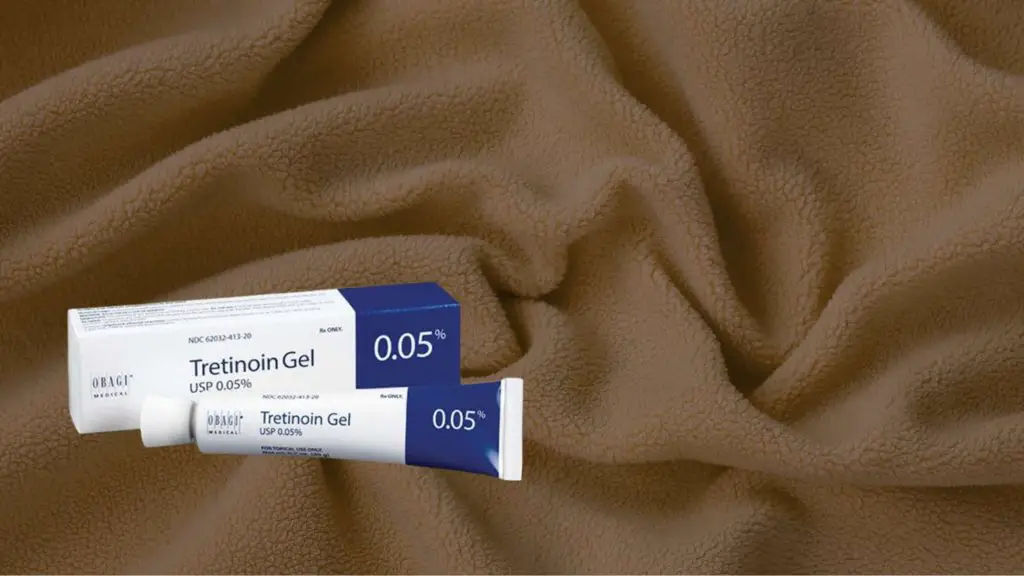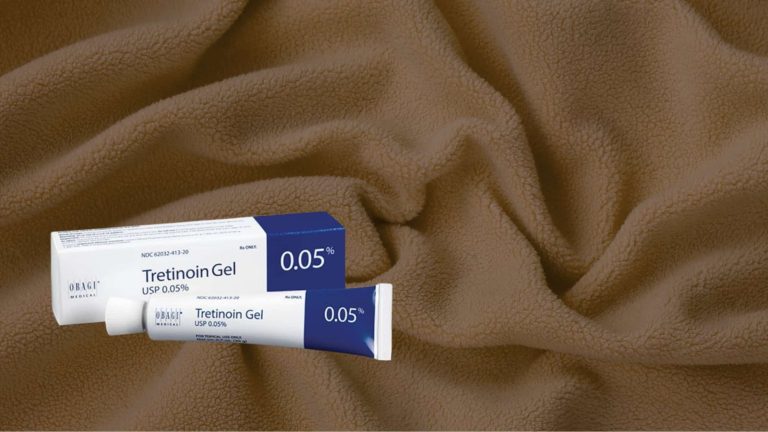Tretinoin has become very popular amongst skincare enthusiasts due to its remarkable effectiveness in treating various dermatological conditions.
People use tretinoin to enhance skin cell turnover, reduce acne, diminish wrinkles, tone skin, and as such its contact with clothes brings up concerns.
However, concerns always arise regarding its potential to bleach clothes and you probably have yourself asking right now does tretinoin bleach clothes?
Well, here is the straightforward answer;
Tretinoin does not bleach clothes. It is not strong enough to discolor your clothes when they come in contact. The 0.025% to 0.1% contained in creams is not enough to cause any fabric bleaching. Using proper detergent is enough to get rid of any tretinoin stains.
In this article, we will explore the effects that tretinoin can have on fabrics and what you can do when the worst happens.
Table of Contents

Does Tretinoin Bleach Clothes?
Generally and practically speaking, Tretinoin does not bleach clothes. It is not strong enough to discolor your clothes when they come in contact. The 0.025% to 0.1% contained in creams is not enough to cause any fabric bleaching.
Unless you are using a highly concentrated form of Tretinoin, you don’t have to worry about your clothes bleaching.
The quantities available in the creams and ointments aren’t concentrated enough to bleach your clothes.
Also, using proper detergent is enough to get rid of any tretinoin stains.
What is Tretinoin made of?
We know you just want to know whether tretinoin will bleach your clothes or not, but let’s look at what tretinoin really is, so we can understand better how it may affect our clothes.
Tretinoin is a form of acid that is known as all-trans retinoic acid and is a derivative of vitamin A. It belongs to the class of medications called retinoids, which are known for their remarkable effects on the skin.
Tretinoin is available in various forms, including creams, gels, and lotions, and is typically prescribed for dermatological conditions such as acne, fine lines, and hyperpigmentation.
The chemical structure of tretinoin enables it to interact with specific receptors in the skin, which leads to a variety of beneficial effects.
Tretinoin’s skin absorption properties
Tretinoin is designed to be absorbed by the skin to exert its beneficial effects.
When applied topically, it can penetrate the outer layers of the epidermis and reach the deeper layers where it interacts with skin cells.
While it is always intended for the skin, tretinoin can sometimes be absorbed to some extent by clothing that comes into contact with it, resulting in the risk of fabric bleaching.
Tretinoin’s potential to transfer onto fabrics
As you may know, the transfer of tretinoin from the skin onto fabrics can occur through various means.
For example, when tretinoin is applied to the face, it may inadvertently come into contact with collars, pillowcases, or towels.
As the skin absorbs the medication, any residual tretinoin present on the surface of the skin can transfer onto your clothes.
Factors that may increase the likelihood of fabric bleaching
Generally speaking, Tretinoin will not bleach your fabrics but there are several factors that can influence the likelihood of your clothes getting bleached by tretinoin:
- The concentration of tretinoin in the topical formulation plays a significant role. Higher concentrations of tretinoin may have a greater potential to cause fabric discoloration.
- The frequency of application and the amount of tretinoin used can also impact the extent of fabric staining.
- Fabric type and composition are crucial factors to consider. Certain fabrics, such as delicate or light-colored materials, may be more prone to discoloration compared to others. Fabrics that have a higher affinity for tretinoin, such as porous materials or fabrics with dyeable fibers, may also be more susceptible to bleaching.
How Does Tretinoin Bleach Clothes?
When highly concentrated tretinoin comes into contact with fabrics, it may undergo chemical reactions that can lead to fabric discoloration or bleaching.
Tretinoin’s impact on fabrics can be influenced by factors such as exposure time. Prolonged contact between tretinoin and fabrics can amplify the potential for color alteration.
Fabric dyes play a crucial role in determining the color and appearance of clothing.
When concentrated tretinoin comes into contact with fabric dyes, it can potentially interact with the dye molecules, leading to alterations in their chemical structure or stability.
This interaction can result in fading, discoloration, or even the complete removal of the dye from the fabric.
How to avoid clothes coming into contact with tretinoin
Here are some tips to minimize the risk of fabric bleaching caused by high concentrations of tretinoin:
- Apply tretinoin at least 20 to 30 minutes before bedtime: This allows sufficient time for the medication to be absorbed into the skin before coming into contact with fabrics, such as pillowcases or collars.
- Avoid excessive application: Using more tretinoin than prescribed does not necessarily yield better results. Stick to the recommended amount to minimize the risk of excessive transfer onto clothes.
- Wear old clothing: When using tretinoin, consider wearing older or darker-colored clothes that are less likely to show stains or discoloration.
Recommendations for safe handling and application of Tretinoin
Safe handling and proper application of tretinoin can also contribute to reducing fabric bleaching incidents:
- Wash hands thoroughly: After applying tretinoin, ensure you wash your hands thoroughly to remove any residual medication that may transfer onto clothing during regular activities.
- Avoid applying tretinoin near clothing edges: When applying tretinoin, be mindful of its proximity to clothing edges, such as collars or cuffs, to minimize the chances of direct contact.
- Allow sufficient absorption time: Give tretinoin enough time to be absorbed into the skin before dressing to minimize the risk of transfer onto clothes.
Can tretinoin bleach things?
Yes, tretinoin at high concentrations has the potential to bleach fabrics and other materials. When tretinoin comes into contact with fabrics, it can undergo chemical reactions that may lead to discoloration or bleaching of the material. It is important to be cautious when using tretinoin to avoid contact with clothing, towels, or other items that may be susceptible to bleaching.
References:
Related Articles:


